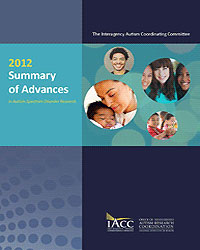Summary of Advances
In Autism Spectrum Disorder Research
2012
Six developmental trajectories characterize children with autism – Fountain C, Winter AS, Bearman PS. Pediatrics. 2012 May;129(5):e1112-20. [PMID: 22473372]
ASD is a neurodevelopmental disorder that varies in both symptoms and progression. While children with ASD usually retain their diagnosis throughout adolescence and adulthood, very little is known about the range of developmental trajectories across the lifespan. Based on a sample of 6,975 children born in California from 1992 through 2001 and enrolled with the California Department of Developmental Services, researchers described the six most common developmental trajectories of ASD progression throughout childhood for each of the three core ASD symptom domains—communication, social functioning, and repetitive behavior. Children with ASD were followed from diagnosis to 14 years of age using birth records and caseload records, which record symptoms, severity, and functioning across several dimensions. The six developmental trajectories identified showed considerable variation in terms of the patterns of severity and developmental progression. Those children whose symptoms were less severe when ASD was diagnosed typically improved more rapidly than those whose symptoms were more severe. Within the sample, the repetitive behavior domain remained largely stable over the study period, with only 15% of the children demonstrating either improvement or worsening of symptoms. However, many children showed significant improvement in the communication and social functioning domains, with the most rapid development occurring in children under the age of 6 with less severe symptoms. Interestingly, for both communication and social functioning domains, approximately 10% of children were identified as “bloomers”—those who had severe symptoms when diagnosed with ASD, but subsequently showed rapid and substantial improvement by adolescence. Children diagnosed with severe autism were most likely to “bloom” if they had no intellectual disability and had white, non-Hispanic mothers with a higher education level. This suggests that socioeconomic status and its impact on such factors as services access may play an important role in the developmental trajectories of children with ASD. Understanding the biological mechanisms and socioeconomic factors underlying these trajectories may yield important information for the development of future interventions and provision of services. Furthermore, the establishment of baseline trajectories will allow for more accurate measurement of the effectiveness of interventions.
Predicting the diagnosis of autism spectrum disorder using gene pathway analysis – Skafidas E, Testa R, Zantomio D, Chana G, Everall IP, & Pantelis C. Mol Psychiatry. 2012 Sep 11. [Epub ahead of print] [PMID: 22965006]
ASD is currently diagnosed based solely upon behavior, with no validated biomarkers to aid in the diagnosis. A genetic test for ASD with a high level of diagnostic accuracy was developed recently, drawing upon current knowledge of the genetics associated with ASD and other neurodevelopmental disorders. The test was developed using data from the Autism Genetic Resource Exchange (AGRE) database which includes genetic data from people with ASD as well as their family members. Researchers examined a central European cohort from the database to identify 237 genetic markers called single-nucleotide polymorphisms (SNPs)—which are differences in a single DNA building block, called a nucleotide—in genes that are known to be involved in biological processes that contribute to or protect an individual from developing ASD. In total, SNPs in 146 genes were identified, but eight SNPs in three genes (KCNMB4, GNAO1, and GRM5) were found to have the largest impact, with some conferring vulnerability for ASD and others conferring protective effects. Based on these genetic markers, researchers developed a test that takes into account both these vulnerability and protective factors when calculating an individual's overall risk for developing ASD. The test was then independently validated in central European individuals from two other databases—the Simons Foundation Autism Research Initiative (SFARI) and the Wellcome Trust 1958 normal birth cohort (WTBC) databases. The test demonstrated more than 70% accuracy in predicting risk of developing ASD in persons of central European descent in the validation sample. Thus, scientists suggest that this test shows considerable promise for detection of ASD in a genetically homogeneous group—where application of the test is limited to individuals of a similar genetic and/or ethnic background to those from which the test was derived. Importantly, the novel methodologies used for the development of this test can be replicated to develop similar tests for use in other ethnic populations. This test may assist in the early detection of ASD in babies, identifying those who would benefit from early interventions, and would be particularly relevant for families who have a history of ASD.




